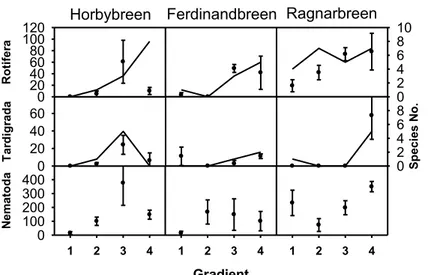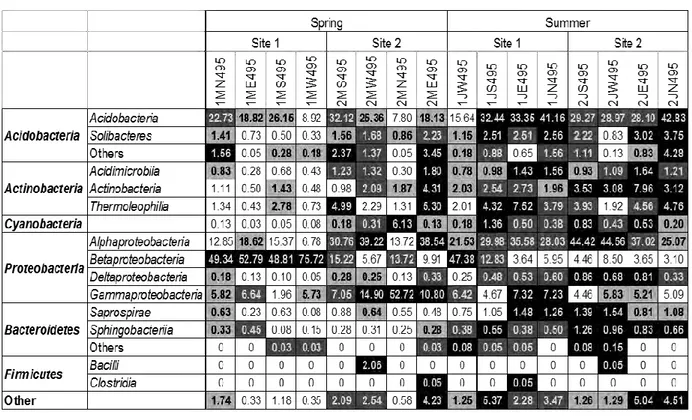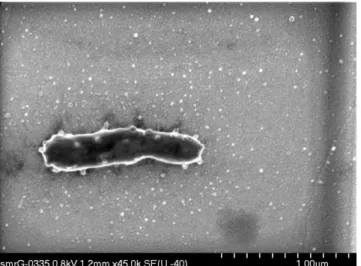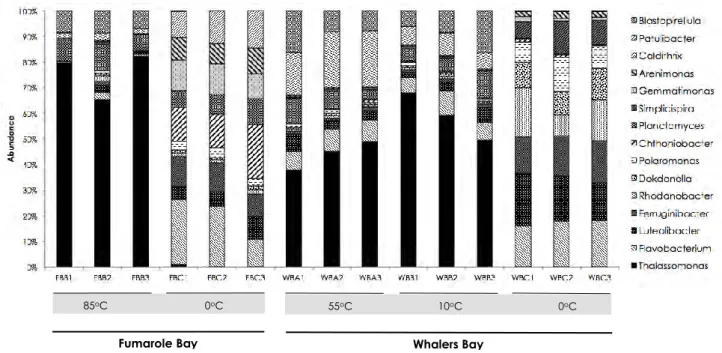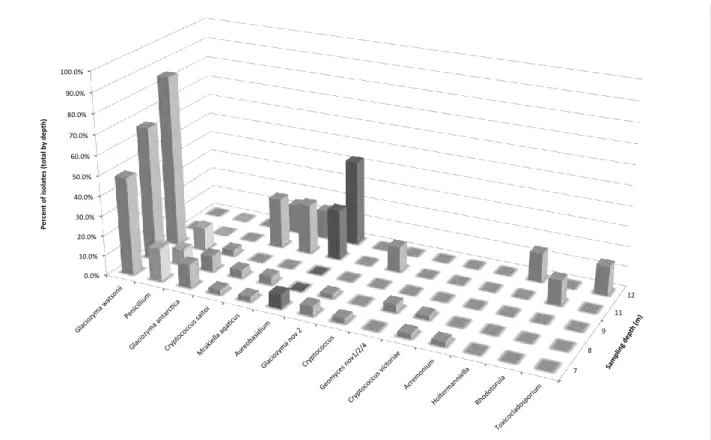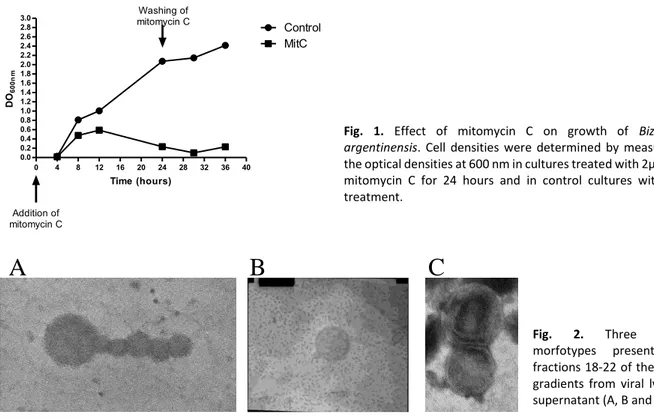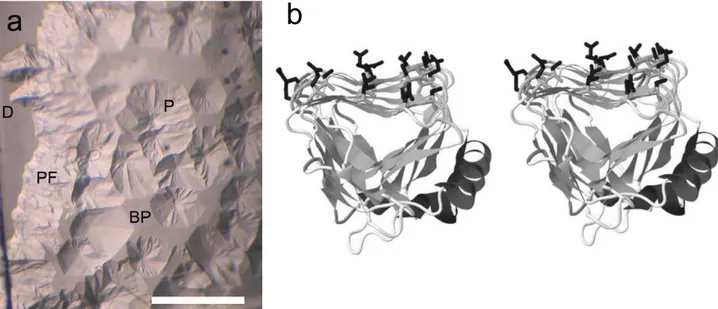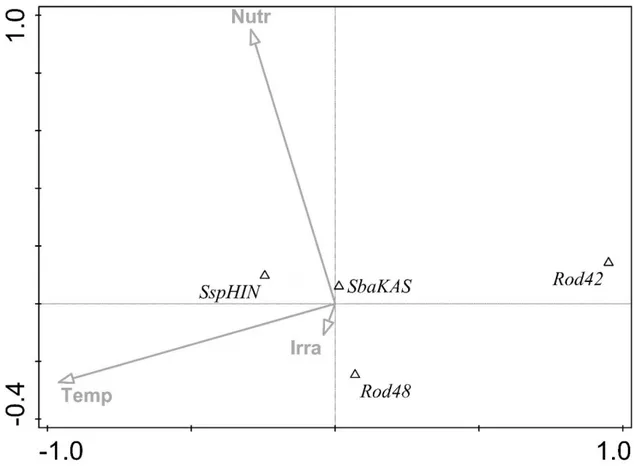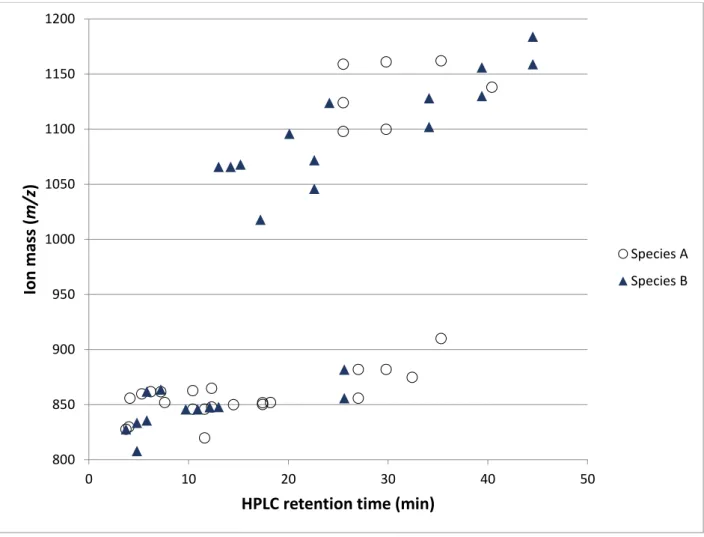Polar
&
Alpine Microbiology
6
th
International Conference
on
Polar and Alpine Microbiology
PAM 2015
6
th
International Conference
on
Polar and Alpine Microbiology
September 6 – 10, 2015
Centre for Polar Ecology, Faculty of Science, University of
South Bohemia in České Budějovice
České Budějovice
Programme & Abstracts
Edited by Jana Kvíderová, Daria Tashyreva, Alexandra Bernardová & Josef Elster
6
THI
NTERNATIONALC
ONFERENCE ONP
OLAR ANDA
LPINEM
ICROBIOLOGYThe conference was organized and with kind support of following institutions: International Arctic Science Committee
Scientific Committee for Antarctic Research
Faculty of Science, University of South Bohemia in České Budějovice (project no. IP15 PO 03) Institute of Botany AS CR (in frame of long-term research development project No. RVO 68985939)
Organizing committee
Josef Elster (Chair)
University of South Bohemia Czech Republic
Max Häggblom
Rutgers University USA
John Priscu
Montana State University USA
Nina Gunde-Cimerman
University of Ljubljana, Slovenia
International Scientific Board
Roland Psenner (Chair)
University of Innsbruck Austria
Marek Stibal (Co-Chair)
Geological Survey of Denmark and Greenland Denmark
Rosa Margensin
University of Innsbruck, Austria
Linda Nedbalová
Charles University, Czech Republic
Satoshi Imura
National Institute of Polar research, Japan
Birgit Sattler
University of Innsbruck, Austria
Annick Wilmotte
Université de Liège, Belgium
Antonio Quesada
Universidad Autónoma de Madrid, Spain
Ľubomir Kováčik
Comenius University in Bratislava, Slovakia
David Pearce
Northumbria University, UK
Rachael Morgan-Kiss
Miami University, USA
Miloš Barták
Masaryk University, Czech Republic
Alex Anesio
University of Bristol, UK
Yoo Kyung Lee
Korean Polar Research Institute, South Korea
Dirk Wagner
German Research Centre for Geosciences, Germany
Ólafur S. Andrésson
University of Iceland, Iceland
Thomas Leya
Humboldt-Universität zu Berlin, Germany
Zorigto B. Namsaraev
Russian Academy of Sciences, Russian Federation
Elie Verleyen
Ghent University, Belgium
Ian Hawes
University of Canterbury, New Zealand
Wim Vyverman
Ghent University, Belgium
Jody W. Deming
University of Washington, USA
Mark Skidmore
Montana State University, USA
Philip A. Wookey
Heriot-Watt University, UK
Anne Jungblut
Natural History Museum, UK
Peter Convey
British Antarctic Survey, UK
Local organizing committee
Alexandra Bernardová University of South Bohemia Jan Kavan University of South Bohemia
Jana Kvíderová University of South Bohemia &
Institute of Botany CAS
Naďa Vithová University of South Bohemia Jana Šnokhousová Institute of Botany CAS Marie Šabacká University of South Bohemia
© Faculty of Science, University of South Bohemia in České Budějovice (2015) ISBN 978-80-7394-528-2
1
I
NTRODUCTIONMessage from the Chair of the PAM2015 Conference
Dear Colleagues,
Since the 1
stPolar and Alpine Microbiology Conference held in Rovaniemi the world microbial society
studying polar and alpine microbes has been meeting regularly every two years (Rovaniemi, Finland
2004, Innsbruck, Austria 2006, Banff, Canada 2008, Ljubljana, Slovenia 2011, Big Sky, USA 2013 and
České Budějovice, Czech Republic 2015).
It is our great privilege to host the conference in our country this year. Czech Republic (and Slovak
Republic, former Czechoslovakia) have been members of the alpine and later polar science community.
At the end of the last century, with opening of the borders between East and West and political changes
in Central and East Europe, Czech polar activities started to flourish. Several expeditions to various parts
of the Arctic and Antarctic have been organized. At present two polar research infrastructures are
managed by the Czech Republic. Since then, the Svalbard archipelago and Antarctic Peninsula are the
main regions of our interest. The Czech Arctic Research Station of Josef Svoboda on Svalbard is managed
by the Centre for Polar Ecology, Faculty of Science, University of South Bohemia in České Budějovice
while the Czech Antarctic research station of J.G. Mendel on James Ross Island is managed by the
Institute of Geography, Faculty of Science, Masaryk University in Brno.
The conferences were always very successful in bringing together the scientific community for discourse
on the latest in all aspects of cold-living microorganisms and their role in polar and alpine environments.
Climate changes that were observed and documented over the last decades brought polar and alpine
areas to the center of attention of the general public and international science community, including
microbiologists. Understanding the processes occurring across polar and alpine environments requires
a coordinated effort over space and time to capture the naturally high variability associated with Polar
and Alpine Regions.
The conference is organized by the Centre for Polar Ecology and I would like to acknowledge support
for this conference from the Faculty of Science, University of South Bohemia in České Budějovice, the
Institute of Botany, Academy of Science of the Czech Republic, Třeboň and the international polar
organizations - the International Arctic Science Committee and the Scientific Committee for Antarctic
Research.
Welcome to České Budějovice, enjoy the Polar and Alpine Microbiology Conference, and enjoy your stay
in the beautiful region of South Bohemia!
Josef Elster
Chair of the Conference
Head of the Centre for Polar Ecology
2
6
THI
NTERNATIONALC
ONFERENCE ONP
OLAR ANDA
LPINEM
ICROBIOLOGYMap of
faci
lit
ie
I
NTRODUCTION4
6
THI
NTERNATIONALC
ONFERENCE ONP
OLAR ANDA
LPINEM
ICROBIOLOGYConference schedule
Sun September 6 Mon September 7 Tue September 8 Wed September 9 Thr September 10
8:00 Registration (Building C lobby) 8:20 Welcome speech (Lecture room) 8:30 Polar/alpine microbiology and environmenral change (Lecture room) Microbial diversity and evolution (Lecture room) Supraglacial, subglacial and glacial microbiology (Lecture room) 10:00 Coffee break
(Building C lobby) (Building C lobby)Coffee break (Building C lobby)Coffee break
10:30 Supraglacial, subglacial and glacial microbiology (Lecture room) 11:50 12:10 Lunch
(Canteen) (Canteen)Lunch
13:00 Microbial diversity and evolution (Lecture room) Supraglacial, subglacial and glacial microbiology (Lecture room) 14:00 Coffee break
(Building C lobby) (Building C lobby)Coffee break
14:30 Coffee break (Building C lobby) 15:00 16:00 16:20 Coffee break (Building C lobby) 16:30 Polar/alpine cyanobacteria (Lecture room) 17:20 Coffee break (Building C lobby) 17:30 18:00 Opening ceremony
(Building C lobby) Closing ceremony(Lecture room)
18:30 19:00 19:10 19:50 20:00 22:00 Poster session A with Budvar beer
(Building C lobby) Poster Session A Official part (Building C lobby) Poster Session A Official part (Building C lobby) Poster session B with Budvar beer
(Building C lobby) Registration (Building C lobby) Coffee break (Building C lobby) Icebreaker party (Building C lobby) Microbial diversity and evolution (Lecture room) Lunch (Canteen) Cold physiology and cryobiology (Lecture room) Cold physiology and cryobiology (Lecture room) Registration (Building C lobby) Coffee break (Building C lobby) Registration (Building C lobby) Polar/alpine microbiology and environmenral change (Lecture room) Exursion (South Bohemia) Conference Dinner (Masné krámy) Polar/alpine eukaryotic microorganisms (Lecture room) Astrobiology of icy worlds (Lecture room) Biotechnology at low temperatures (Lecture room)
5
C
ONFERENCE PROGRAMMEConference programme
Sunday September 6, 2015
16:00 - 21:00 Registration 18:00 - 18:30 Opening ceremony 18:30 - 22:00 Icebreaker party
Monday September 7, 2015
8:00 - 17:00 Registration 8:20 - 8:30 Welcome speechA. Polar/alpine microbiology and environmental change: past, present and future
Minna K. Männistö (Chair)
Finnish Forest Research Institute, Rovaniemi, Finland Max Häggblom (Co-Chair)
Rutgers University, USA
8:30 - 9:00 Minna K. Männistö
The impact of large grazers on the responses of soil microbial communities to warming and increased nitrogen avaiability
KN-A
9:00 - 9:20 Alexandre Anesio Microbial succession from ice to vegetated soils in the High Arctic
L-A-01 9:20 - 9:40 Craig Cary Resolving spatial and temporal heterogeneity in
terrestrial Antarctic microbial communities
L-A-02 9:40 - 10:00 Max Häggblom Bacterial utilization of carbon and nitrogen at subzero
temperatures in tundra soils
L-A-03
10:00 - 10:30 Coffee break
10:30 - 10:50 Elisabeth Helmke Arctic bacterial sea ice communities affected by global warming
L-A-04 10:50 - 11:10 Anne Jungblut Microbial mat communities along environmental
gradients in perennially ice covered Antarctic lakes
L-A-05 11:10 - 11:30 Gabriela Mataloni Microbial planktonic communities as environmental
indicators in a Tierra del Fueglo peat bog
L-A-06 11:30 - 11:50 Laura Selbmann Environmental pressure and variation of fungal
biodiversity in rock microbial communities of Northern Victoria Land (Antarctica)
L-A-07
11:50 - 12:10 Ruben Sommaruga
Changes in bacterial community composition along a turbidity gradient in recently-formed lakes in SW Greenland
L-A-08
6
6
THI
NTERNATIONALC
ONFERENCE ONP
OLAR ANDA
LPINEM
ICROBIOLOGYC. Cold physiology and cryobiology
Anders Priemé (Chair)
Geological Survey of Denmark and Greenland, Copenhagen, Denmark Antonio Quesada (Co-Chair)
Universidad Autónoma de Madrid, Spain
13:00 - 13:30 Andres Priemé Microbial activity in newly thawed permafrost soil KN-C 13:30 - 13:50 Klaus Herburger Callose acts against desiccation: induced forces
in filamentous streptophyte green algae from alpine regions
L-C-01
13:50 - 14:10 Thulani Makhalanyane
Meta-omic analysis reveals widespread functionality in Antarctic hypoliths from two Dry Valley system
L-C-02 14:10 - 14:30 Riitta Nissinen Some like it cold, some like it green, some like it cold
and green - comparative genomics of sphingomonads associaated with Arctic plants
L-C-03
14:30 - 15:00 Coffee break
15:00 - 15:20 Elena Patova Nitrogenase activty of soil cyanobacterial crusts in polar and subpolar Urals (European North-East Russia)
L-C-04 15:20 - 15:40 James Raymond Ice binding proteins of a snow alga, Chloromonas
brevispina: probable acquisition by horizontal gene
transfer
L-C-05
15:40 - 16:00 Daria Tashyreva The limits of desiccation tolerance of Arctic Microcoleus strains (Cyanobacteria) and environmental factors inducing it
L-C-06
16:00
- 16:20 Cinzia Verde Coping with cold: from the structure to the function of Antarctic bacterial globinsL-C-07
16:20
- 16:30 Coffee breakPoster session A
16:30 - 17:30 Official part - Posters from Sections A, C, D and G; followed by beer party
Tuesday September 8, 2015
8:00 - 17:00 Registration
B. Microbial diversity and evolution
David Pearce (Chair)
Northumbria University, Newcastle, UK Dirk Wagner (Co-Chair)
German Research Center for Geosciences, Potsdam, Germany
8:30 - 9:00 David Pearce So what is in the atmosphere - the last piece of the jigsaw?
7
C
ONFERENCE PROGRAMME9:00 - 9:20 Natalia Belkova Variety and diversity of representatives of 'candidate' phyla in cold seeps from Sayan Mountains (Siberia, Russia)
L-B-01
9:20 - 9:40 Martin Hartmann Unraveling the unknown microbial diversity hidden in alpine permafrost
L-B-02 9:40 - 10:00 Christoph
Keuschnig
Arctic snowpack-soil interface - strict boundary or ecosystem trading zone?
L-B-03
10:00 - 10:30 Coffee break
10:30 - 10:50 Yung Mi Lee Draft genome of members of the OP9 lineage obtained from single cells sorted from a marine sediment of the Ross Sea, Antarctica
L-B-04
10:50 - 11:10 John Priscu Methane transormations in Arctic and Antarctic ice-covered lakes
L-B-05 11:10 - 11:30 Sara Rassner It pays to be a winner: viral control of the bacterial
community of a High Arctic glacier surface
L-B-06 11:30 - 11:30 Elizaveta Rivkina Metagenomics of permafrost - key for paleoecology L-B-07 11:50 - 12:10 Viktoria
Shcherbakova
Sulfate-reducing bacteria in Arctic gryopegs L-B-08
12:10 - 13:00 Lunch
13:00 - 13:20 Guillaume Tahon Diversity of cbbL, nifH and pufLM genes in soils around the Princess Elizabeth Station, Sør Rondane Mountains, Antarctica
L-B-09
13:20 - 13:40 Bernhard Tschitschko
Host-virus interaction in a frigid, hypersaline Antarctic lake revealed by metaproteomics
L-B-10 13:40 - 14:00 Marc
Van Goethem
Microbial communities of Antarctic soil and lithic habitats
L-B-11
14:00 - 14:30 Coffee break
F. Polar/alpine eukaryotic microorganisms
Wim Vyverman (Chair)
Ghent University, Belgium Nina Gunde-Cimerman (Co-Chair)
University of Ljubljana, Slovenia 14:30 - 15:00 Wim Vyverman
Elie Verleyen
Post-Miocene divergence of polar diatom biomes KN-F 15:00 - 15:20 Nina
Gunde-Cimernan
Black yeasts from glaciers to sauna - biological answer to a changing world?
L-F-01 15:20 - 15:40 Maxime
Sweetlove
Biogeographic zoning of aquatic microeukaryotes in the Antarctic realm
L-F-02 15:40 - 16:00 Tatiana
Vishnivetskaya
Hunting for green algae and cyanobacteria in Siberian permafrost
L-F-03
8
6
THI
NTERNATIONALC
ONFERENCE ONP
OLAR ANDA
LPINEM
ICROBIOLOGYE. Polar/alpine cyanobacteria
Jiří Komárek (Chair)
Academy of Science, Institute of Botany, Třeboň, Czech Republic Annick Wilmotte (Co-Chair)
Liege University, Belgium
16:30 - 17:00 Jiří Komárek Polar/Alpine cyanobacteria KN-E 17:00 - 17:20 Antje Donner Diversity of hypolithic cyanobacteria from three
locations in western Spitsbergen
L-E-01
17:20 - 17:30 Coffee break
Poster session B
17:30 - 18:30 Official part - Posters from Sessions B, F, E and H; followed by beer party
Wednesday September 9, 2015
8:00 - 12:00 Registration
D. Supraglacial, subglacial and glacial microbiology
Andy J. Hodson (Chair)
University of Sheffield, UK Marek Stibal (Co-Chair)
Charles University, Prague, Czech Republic
8:30 - 9:00 Andy J. Hodson The ecology and biogeochemistry of maritime Antarctic snow
KN-D 9:00 - 9:20 Liz Bagshaw Light adaptation of microbial communities in Antarctic
cryoconite holes
L-D-01 9:20 - 9:40 Karen Cameron Export of microbial cells from the Greenland Ice Sheet L-D-02 9:40 - 10:00 Andrea Franzetti Dynamics and microbial community functions in
cryoconite from Italian Alps and Karakoram
L-D-03
10:00 - 10:30 Coffee break
10:30 - 10:50 Stefanie Lutz Biogeography and functionality of microbial glacial surface communities across the Arctic
L-D-04 10:50 - 11:10 Lorrie Maccario Microbial life in the arctic snowpack photochemical
reactor
L-D-05 11:10 - 11:30 Birgit Sattler Settlement of an Alpine englacial system with microbial
communities - who comes first?
L-D-06 11:30 - 11:50 Takahiro Segawa The nitrogen cycle in cryoconites: naturally occurring
nitrification-denitrification granules on a glacier
L-D-07
11:50 - 13:00 Lunch
13:00 - 13:20 Mark Skidmore Linking elemental cycles in subglacial systems through microbial processes
9
C
ONFERENCE PROGRAMME13:20 - 13:40 Marek Stibal The role of ice algae in the albedo feedback on the Greenland Ice Sheet
L-D-09 13:40 - 14:00 Jon Telling Between a rock and a hard place: rock comminution as
a source of hydrogen for subglacial systems
L-D-10
14:00 - 14:30 Coffee break
H. Astrobiology of icy worlds
Jean-Pierre Paul de Vera (Chair)
Institute of Planetary Research, Berlin, Germany Silvano Onofri (Co-Chair)
Università della Tuscia, Italy 14:30 - 15:00 Jean-Pierre
de Vera
Potential biospheres in the icy worlds in our solar system KN-H 15:00 - 15:20 Sergey Bulat Microbiology of the subglacial lake Vostok: First results
with borehole-frozen lake water and prospects
L-H-01 15:20 - 15:40 Silvano Onofri BIOMEX experiment: survival, urltrastructural and
molecular damage in the cryptoendolithic Antarctic fungus Cryomyces antarcticus exposed to space and simulated Mars-like conditions
L-H-02
15:40 - 16:00 Dirk Wagner Methanosarcina soligelidi SMA-21 - an archaeal
candidate for life on Mars
L-H-03
16:00 - 16:30 Coffee break
G. Biotechnology at low temperatures
Rosa Margesin (Chair)
Innsbruck University, Austria Giuseppe Torzillo (Co-Chair)
CNR - Istituto per lo Studio degli Ecosistemi, Sesto Fiorentino, Italy
16:30 - 17:00 Rosa Margesin Biotechmological significance of microorganisms in low temperature environments
KN-G 17:00 - 17:20 Lorena
Monserrate Maggi
Bioprospecting of Hg processing micro-organisms from South Shetlands Island, Antarctica
L-G-01
17:20 - 17:40 Giuseppe Torzillo Development of photobioreactors for low-temperature environment
L-G-02 17:40 - 18:00 Oddur
Vilhelmsson
Naphatlene-degrading bacteria associated with terricolous lichens in Iceland
L-G-03 -
18:00 - 18:30 Closing ceremony 20:00 - 22:00 Dinner at Masne Kramy
Thursday September 10, 2015
-
10
6
THI
NTERNATIONALC
ONFERENCE ONP
OLAR ANDA
LPINEM
ICROBIOLOGYPoster session A
Poster
No Presenting author Title
1 Ingeborg Bussmann Methane oxidation and methane distribution around the
Lena Delta, Siberia, Russia P-A-01
2 Alica Chroňáková
Microbial community development on deglaciated soils in High Arctic (Svalbard) in comparison to sub-Arctic continental regions
P-A-02 3 Miloslav Devetter Terrestrial invertebrates along a gradient of deglaciation
in Svalbard: relation to microbial communities P-A-03 4 Kateřina Diáková Microbial biomass as an indicator of carbon losses from
subarctic tundra soils in changing environment P-A-04 5 Roman Dial Snow algae increases snowmelt: results of manipulative
experiment on the Harding Icefield, Alaska P-A-05 6 Richard Hill Spatial and temporal inluences on Arctic soil microbial
comminity structure P-A-06
7 Katrin Hofmann Spatial patterns of methane-cycling microorganisms
in soils of a high-alpine altitudinal gradient P-A-07 8 Weidong Kong
Diversity and succession of autotrophic microbial communities in high-elevation soils along deglaciation chronosequence
P-A-08
9 Richard Lamprecht
Soil mineralization sensitivity to temperature and O2 availability in deep peat profiles including permafrost interface
P-A-09
10 Yongqin Liu
Ice cores from the Tibetian Plateau reveal microbial activity convergence related to climate and anthropogenic activity
P-A-10
11 Alena Lukešová
Role of soil algae and cyanobacteria in colonization and succession on deglaciated soils in High Arctic (Svalbard) and alpine/subalpine regions (Scandinavia)
P-A-11
12 Rosa Margesin Effect of altitude and season on microbial functionalizy,
community structure and abundance in alpine forest soils P-A-12 13 Alejandro Mateos-Rivera Shifts in microbial community structure in a glacier
forefield (Styggedalsbreen, Central Norway) P-A-13 14 Luis Morgado Compositional shifts in ectomycorrhizal fungal community
in response to long-term snow depth increase P-A-14 15 Hyun-Ju Noh
Complex and varying lichen microbiomes according to vertical position of thallin in Cladonia gracilis from King George Island, Antarctica
P-A-15
16 Krzysztof Romaniuk
Impact of human presence and activity on ecology and adaptation of an Antarctic psychrophilic bacteria communities
P-A-16
17 Carolina Voigt
Climate feedback of arctic ecosystems: Warming enhances nutrient turnover and alters carbon and nitrogen flux dynamics in subarctic tundra
P-A-17 18 Jana Voříšková Microbial community responses to future climate change
abd seasonal variation in Arctic tundra soil P-A-18 19 Maya Bar Dolev An antarctic sea ice bacterium that uses an Ice Binding
Protein to adhere to ice P-C-01
20 Miloš Barták
Resistance of Antarctic Nostoc sp. colonies to dehydration assessed by chlorophyll fluorescence parameters and spectral reflectance
11
C
ONFERENCE PROGRAMME21 Peter Convey Do Chlorella strains respond differently to temperature
stress across a global gradient? P-C-03 22 Fariha Hasan Isolation and some unique physiological characteristics
of psychrotropic fungi from Passu Glacier, Pakistan P-C-04 23 Tyler Kohler
Biotic and abiotic controls of the elemental and isotopic composition of microbial communities in McMurdo Dry Valley streams, Antarctica
P-C-05
24 Anton Kurakov
Charaterization of plasmids and plasmid-encoded resistance genes found in permafrost Acinetobacter
iwoffii strains
P-C-06 25 Jana Kvíderová Growth requirements of Stichococcus sp. strains isolated
from Rhodope Mountains, Bulgaria P-C-07 26 Yan Liao Proteomics and genetics of Haloarchaea from deep lake,
Antarctica P-C-08
27
Phaik-Eem Lim
Photosynthesis and genomic responses of Chlorella species from different geographical regions to artificial ultraviolet radiation (UVR) stress
P-C-09 28 Oliver Müller Changes in structure, activity and metabolic processes of
microorganisms in thawing permafrost soils from Svalbard P-C-10 29 Felipe Nóbrega Prospection and desiccation tolerance of polar
microorganisms P-C-11
30 Ksenia Novototskaya-Vlasova
The molecular basis of thermostability of coldactive esterase from psychrotrophic bacterium Psychrobacter
cryohalolentis K5T
P-C-12 31 Amedea Perfumo A single cell view of the growth of anaerobic bacterium
Clostridium psychrophilum at subzero temperatures P-C-13
32 Lada Petrovskaya
New autotransporter from Psychrobacter cryohalolentis K5T: characterization and construction of cell surface display system
P-C-14 33 Martina Pichrtová Desiccation stress and resistance in polar green algae of
the genus Zygnema P-C-15
34 Lenka Procházková Light and temperature dependence of photosynthesis in
Chlamydomonads isolated from snow P-C-16
35 Daniel Remias Significant cytological and physiological differences
between two green algae causing red snow in the Alps P-C-17 36 Carina Rofner
Differential utilization patterns of dissolved organic phosphorus compounds by heterotrophic planktonic bacteria
P-C-18 37 Krzysztof Romaniuk Adaptive features encoded within plasmids of arctic and
antarctic Psychrobacter spp. P-C-19
38 Roberta Russo
Structural nad functional analysis of water-borne signaling protein pheromones from bipolar protisi ciliate, Euplodes
petzi
P-C-20 39 Laura Sanguino Viral-host interactions in glacial ice and their adaptive
significance P-C-21
40 Iris Schaub
Effect of prolonged darkness and temperature on the lipid metabolism in the benthic diatom Navicula perminuta ffrom the Arctic
P-C-22 41 Morten Schostag Microbial transcriptomic response to thawing and
freezing of active layer permafrost soil P-C-23 42 Purnima Singh Antifreeze protein activity in glacier cryoconites P-C-24 43 Kateřina Snopková Cold-active antimicrobial agents produced by Antarctic
12
6
THI
NTERNATIONALC
ONFERENCE ONP
OLAR ANDA
LPINEM
ICROBIOLOGY44 . Taha
Phylogenetic, structural and nucleic acid binding properties of a novel type of RNA-binding (TRAM) protein from an Antarctic archaeon.
P-C-26
45 Susana Vazquez
Crystal structure and expression of a putatibe phage-like protein coded in the genome of a marine Antarctic bacteria
P-C-27 46 James Bradley Microbial community dynamics in the forefield of glaciers
– a modelling perspective P-D-01
47 Beat Frey Microbial diversity of the cryosphere of the Damma
glacier P-D-02
48 Jan Gawor Arctic and Antarctic supraglacial bacterial diversity
revealed by next generation metagenomics P-D-03 49 Jarishma Gokul The biogeography of cryoconite bacterial communities on
a High Arctic Ice Cap P-D-04
50 Dorota Górniak
Bacterial community composition in various supraglacial habitats of Ecology Glacier (King George Island, Antarctica)
P-D-05 51 Jakub Grzesiak Microbial community changes along the Ecology Glacier
ablation zone (King George Island, Antarctica) P-D-06 52 Takumi Murakami Survey of the glacier invertebrates and their gut
microbiota P-D-07
53 Sabrina Obwegeser
Cover up – coverage of glacial surfaces with industrial fleece to reduce ablation: economic blessing or ecological spell? A symbiosis of society and science
P-D-08 54 Marie Šabacká The ecology and biogeochemistry of maritime Antarctica
snow P-D-09
55 Shiv
Mohan Singh
Bacterial diversity and bio-potentials of Himalayan
cryoconites, and its comparison with Arctic P-D-10 56 Jun Uetake Bacterial diversity in tropical glacier and glacier foreland
in Uganda P-D-11
57 Alejandra Urra Investigation of the proglacial zone as a modulator for
nutrient fluxes in ice sheet runoff P-D-12 58 Jakub Žarský Greenland Ice Sheet as a model for microbial
macroecology and evolution P-D-13
59 Ioan Ardelean
Biosynthesis of gold nanoparticles by a cryotolerant cyanobacterium isolated from Scarisoara Ice Cave (Romania)
P-G-01 60 Heida Fridjonsdottir Bioprospecting psychrotrophic sphingomonads for
hydrocarbon degradation P-G-02
61 Maria Papale Polychlorinated biphenyl degrading bacteria from the
Kongfjorden (Svalbard Islands, Norway) P-G-03 62 Maria Papale
Tolerance to heavy metals and polychlorinated biphenyl biodegradation potential by Arctic bacteria from continental Norway
P-G-04 63 Jeffrey Vargas-Perez Bioprospecting of antarctic microorganisms and their
13
C
ONFERENCE PROGRAMMEPoster session B
Poster
No Presenting author Title
1 Antonio Alcamí Biodiversity and distribution of polar freshwater viruses P-B-01 2 Antonio Alcamí Ecological connectivity shapes viral assemblages and
variability in Antarctic environments P-B-02 3 Corien Bakermans Attempted isolation of Acidobacteria from Antarctic
permafrost P-B-03
4 Chris Bellas Virus genomes from glacial environments reveal novel
virus grpups with unusual host interactions P-B-04 5 Amanda Bendia Microbial communities from geothermal sites of a polar
active volcano (Deception Island, Antarctica) P-B-05 6 Nadine Borchhardt
Biological soil crust algae in the polar regions – biodiversity, genetic diversity and ecosystem resilience under global change scenarios
P-B-06
7 Heather Buelow
Differential abundance and expression of Antarctic soil microbial communities: a metatranscriptomic analysis of taxonomic and functional diversity
P-B-07 8 Kelly Chan-Yam Characterization of microbial communities in water tracks
in an Antarctic Dry Valley P-B-08
9 Laurie Connell Fungal diversity in permanently ice covered Lake Fryxell,
Antarctica P-B-09
10 Antonella Conte Cultivable heterotrophic bacteria from Antarctic
permafrost P-B-10
11 Antonella Conte Experimental approach to the screening of prokaryotic
assemblage in Antarctic permafrost P-B-11 12 Silvia Coria Induction of multiple prophages from an Antarctic marine
bacterium P-B-12
13 Olga Dagurova Controlling factors on bacterial diversity and activity of the
coastal water of Lake Baikal, Siberia P-B-13 14 Ekaterina Dambinova Psychrophilic and psychroactive bacteria in cold springs of
Northern Pribaikalie P-B-14
15 Ekaterina Durdenko Halophilic aerobic microorganims from Alyaska cryopeg P-B-15 16 Diego Franco
Microbial diversity and community composition across depth gradient in marine sediments from Admiralty Bay, King George Island and Bransfield Strait, Antarctica
P-B-16 17 Chung
Yeon Hwang
Marine RNA virus communities of oceanic seawaters in
the vicinity of the Antarctic Peninsula P-B-17 18 Nataliia Iakovenko How unique are the micrometazoa of antarctic soils? The
example of bdelloid rotifers P-B-18
19 Corina Itcus Diversity of cultured ice cave microcosm P-B-19 20 Ok-Sun Kim Comprehensive analysis of soil bacterial community
structure in King George Island, Maritime Antarctica P-B-20 21 Andrea Kiss Epi- and endophytic microbial communities of Arctic and
subarctic peatland mosses P-B-21
22 Kirill Krivushin Metagenomic insights into Antractic Dry Vallys permafrost P-B-22 23 Emanuele Kuhn Transportation nad persistence of microbial cells in
central West Antarctica P-B-23
24 Manoj Kumar Biogeographical diversity of root associated microbial
communities in arctic and alpine tundra areas P-B-24 25 Hong
Kum Lee
Polar and Alpine Microbial Collection (PAMC): a culture
14
6
THI
NTERNATIONALC
ONFERENCE ONP
OLAR ANDA
LPINEM
ICROBIOLOGY26 Inae Lee
Genomic and phenotypic characterization of a thermophilic Bacillus sp. 9F isolated from deep-sea hydrothermal vent plume, Southern Ocean
P-B-26 27 Yung Mi Lee Stratification of microbial community in marine sediments
of the Ross Sea, Antarctica P-B-27
28 Li Liao Bio-mining the actinobacterial treasures of the Arctic
Ocean: diversity and genetic resources P-B-28 29 Susanne Liebner Microbial abundance and methanotrophy in degrading
subsea permafrost from the Laptev Sea shelf, Siberia P-B-29 30 Evgeniya Matyugina Diversity and ecology of microorganisms from cold seeps
of National park "Alkhanai" (Transbaikalia, Russia) P-B-30 31 Viktoriya Oshurkova The search of methanogenic archaea in Arctic and
Antarctic permafrost P-B-31
32 Cristina Purcarea Prokaryotic community structute across the ice block of
Scarisoara Cave determined by 454 pyrosequencing P-B-32 33 Ana
Judith
Russi Colmenares
Community composition, diversity and activity of N fixing cyanobacteria associated with mosses in sub-Arctic alpine ecosystems
P-B-33
34 Iara Santiago
Lichensphere: a protected natural microhabitat of the non-lichenized fungal communitieds living in extreme environments of Antarctica
P-B-34 35 Tina Šantl-Temkiv Aerial transport of bacterial cells in the Arctic: sources,
deposition and impact on atmospheric processes P-B-35 36 Bjorn Tytgat Bedrock and biotic influence on community composition
in soils from the Sør Rondane Mountains, East Antarctica P-B-36 37 Bjorn Tytgat Biogeographic patterns in Antarctic lacustrine prokaryotes P-B-37 38 Annick Wilmotte
A plea for the creation for inviolate areas to protect reference arear for future microbiology research in Antarctica
P-B-38
39 Tina Wunderlin
Bacterial geography of high altitude snow -compering diversity in snow from Jungfraujoch (Switzerland) and Snowy Mountains (Australia)
P-B-39
40 Soo
Jeong Yoon
High occurence of thermophilic bacteria isolated from hydrothermal vent plumes in Australian-Antarctic Ridge, Southern Ocean
P-B-40 41 Marek Zdanowski Molecular characterization of miniature plasmids of Arctic
psychrophilic bacteria of the genus Variovorax P-B-41 42 Yinxin Zeng
Diversity of pufM and g5 genes in Bacterioplankton communities in coastal seawaters of Fildes Peninsula, King George Island, Antarctica
P-B-42 43 Nathan Chrismas The evolution of cold tolerance in cyanobacteria P-E-01 44 Ľubomír Kováčik
Characterization of ten strains of filamentous cyanobacteria from the South Shetland Islands , Maritime Antarctica
P-E-02
45 Anna Patova
Morphological and molecular characteristics of Nostoc
commune Vauch. ex Born. & Flah. populations in
mountain and Arctic habitats
P-E-03 46 Cristina Purcarea Diversity pf phototrophic bacteria in Scarisoara Ice Cave P-E-04 47 Ekaterina Pushkareva Impact of environmental factors on soil crust community
in Svalbard P-E-05
48 Lenka Raabová Thin and ubiquitous: taxonomic features of Leptolyngbya
in Polar Regions P-E-06
49 Annick Wilmotte A next-generation protocol for the assessment of
15
C
ONFERENCE PROGRAMME50 Annick Wilmotte Baseline on cyanobacterial biodiversity of Svalbard
asessed by pyrosequencing P-E-08
51 Annick Wilmotte The BCCM/ULC culture collection to conserve, document
and explore the polar cyanobacterial diversity P-E-09 52 Olga Baulina The biodiversity and plasticity of symbiotic Desmodesmus
spp. (Chlorophyceae) from a subarctic sea P-F-01 53 Kateřina Kopalová Diatoms from the maritime Antarctica region; extreme
endemism in Antarctica P-F-02
54 Kateřina Kopalová An intriguing species of Eunotia (Bacillariophyta) from
Gough Island (Tristan da Cunha archipelago) P-F-03 55 Kateřina Kopalová Revision of the genus Nitzschia in the maritime Antarctic
Region P-F-04
56 Kateřina Kopalová
The genus Luticola D.G.Mann (Bacillariophyta) from the McMurdo Sound Region, Antarctica, with description of four new species
P-F-05 57 Ľubomír Kováčik Exposition of various stress conditions on filamentous
green alga Klebsormidium (Streptophyta) P-F-06 58 Jana Kvíderová New record of cryoseston on Olympus Mt., Greece P-F-07 59 Dial Laughinghouse Unique diversity of marine microbial eukaryotes in the
High Arctic P-F-08
60 Roksana Majewska Epiphytic diatom communities from Terra Nova Bay and
Cape Evans (Ross Sea) - a synthesis P-F-09 61 Tomomi Nakashima
Temporal and spatial variations in pigment compositions of snow algae in Mt. Tateyama in Toyama prefecture, Japan
P-F-10
62 Linda Nedbalová
Identity and ecophysiology of coccoid green alga dominating in ice-covered lakes on James Ross Island (NE Antarctic Peninsula)
P-F-11 63 Eveline Pinseel Hidden diversity: multiple Arctic and Antarctic lineages in
the cosmopolitan diatom Pinnularia borealis P-F-12 64 David Ryšánek Diversity and spatial capacities of Arctic terrestrial algae P-F-13 65 Klemens Weisleitner
Advances in laser-induced fluorescence emision technology (L.I.F.E.) and preliminary microbial data from an Antarctic glacier
Session A
Polar/alpine microbiology and environmental change
21
A.
P
OLAR/
ALPINE MICROBIOLOGY AND ENVIRONMENTAL CHANGEKeynote lecture KN-A
THE IMPACT OF LARGE GRAZERS ON THE RESPONSES OF SOIL MICROBIAL COMMUNITIES TO WARMING AND INCREASED NITROGEN AVAILABILITY IN SUB-ARCTIC TUNDRA
Minna Männistö1, Lars Ganzert1,2, Maria Väisänen3, Marja Tiirola4, Saija Ahonen1, Max Häggblom5, Sari Stark3 Natural Resources Institute Finland, Rovaniemi, Finland1, Leibniz Institute of Freshwater Ecology and Inland Fisheries, Stechlin, Germany2, Arctic Centre, University of Lapland, Rovaniemi, Finland3, Dept. of Biological and
Environmental Science, University of Jyväskylä, Finland4, Dept. of Biochemistry and Microbiology, Rutgers University, USA5
Arctic tundra soils store large quantities of the global organic carbon pool and hence there is considerable interest in understanding how this carbon will respond to environmental changes caused by a warming climate. Regulators of SOM decomposition are, however, complex and it is not well known how different feedback mechanisms will influence carbon and nitrogen cycling in the future climate. One of the key limitations in understanding the drivers of SOM decomposition is our still very poor understanding of the microbial communities, how the environmental factors drive the community structure and function and how the microbial community structure influences the C and N cycling.
Large grazers, particularly reindeer, influence the tundra ecosystems drastically through faeces, trampling and selective grazing leading to changes in vegetation, soil microclimate, nutrient availability, and quality and quantity of litter and soil carbon. All these factors influence the carbon and nutrient cycles with a consequence that long-term reindeer grazing may diminish the effects of warming on ecosystem net carbon balance. To understand links between grazers and microbial responses to global change, we have conducted field and laboratory experiments in soils from Raisduoddar, Norway. A pasture rotation fence divides the area to a lightly grazed winter pasture with lower N availability, lower soil temperature and shrub dominated vegetation and to a highly grazed summer pasture with high N availability, higher variation in soil temperature and grass dominated vegetation. The effects of experimental warming and fertilization were characterized by Ion Torrent sequencing of bacterial 16S rRNA amplicons, soil respiration, extracellular enzyme activities and soil physico-chemical analyses.
The-experimental treatments had significant effects on the microbial communities but the magnitude and/or direction of the effects depended on the grazing intensity. Warming had little influence on the microbial community structure or activities in the heavily grazed tundra. In the lightly grazed tundra, however, warming shifted the bacterial community significantly and increased e.g. the abundance of several Actinobacteria taxa. Fertilization increased the proportion of carbohydrates in soil with a concomitant increase in microbial activities related to carbon degradation. In lightly grazed tundra fertilization increased several OTUs related to
Actinobacteria, while in heavily grazed tundra fertilization was linked especially to the increase in taxa related to
the Dyella/Rhodanobacter group (Gammaproteobacteria). Similarly as reported for warmer soils, fertilization favoured copiotrophic species (Actinobacteria, Gammaproteobacteria) while oligotophic taxa (e.g Acidobacteria,
Verrucomicrobia) decreased. The results indicate, however, that in the fennoscandian tundra, the effects of
fertilization were mediated through changes in organic matter quality rather than N availability directly. Put together, our results indicate that reindeer mediated changes in the soil chemical composition and microclimate have a profound influence on the structure and functional adaptation of soil microbial communities. This role of large grazers may be a key mechanism determining the impact of warming in carbon fluxes in the tundra. KEYWORDS: MICROBIAL COMMUNITIES, ARCTIC TUNDRA, ENZYME ACTIVITIES, NEXT-GENERATION SEQUENCING, GRAZING
22
6
THI
NTERNATIONALC
ONFERENCE ONP
OLAR ANDA
LPINEM
ICROBIOLOGYLecture A-01
MICROBIAL SUCCESSION FROM ICE TO VEGETATED SOILS IN THE HIGH ARCTIC
Alexandre M. Anesio1, Gary Barker2, Marie Sabacka1, Katherine Wright1, Joshua Blacker3, Stefanie Lutz3, James Bradley1, Sandra Arndt1, Marian Yallop2, Martyn Tranter1 and Liane G. Benning3,4
School of Geographical Sciences, Univ of Bristol, BS8 1SS, UK1, School of Biological Sciences, Univ of Bristol, BS8 1TQ, UK2, School of Earth & Environment, Univ of Leeds, LS2 9JT, UK3, German Research Centre for Geosciences,
GFZ, 12273 Potsdam, Germany4
Glaciers in the Northern Hemisphere are retreating and their forefields present a unique opportunity to investigate the initial phases of soil weathering/formation and microbial succession in terrestrial cold habitats. In Arctic environments, the relative importance of primary autotrophic microbial colonisers (e.g. cyanobacteria and chemolithotrophs), input of allochthonous sources and recycling of ancient organic carbon during the initial phase of soil establishment is still debated. In glacial forefields, microbes that have colonised both glacial surfaces and subglacial debris may provide an important inoculum for the development of microbial communities. In this study, during the summer in 2013, we collected soil samples along three replicated transects from the margin of the Mitdre Lovénbreen (Svalbard, Norway). These transects represent a chronosequence between 0 and ~ 2000 years dated based on geomorphological data. We cross-compared these soil samples with samples from the glacial surface and basal sediments. Analyses of microbial community composition (ssu rRNA gene), activity (C fluxes, N-fixation, and C utilisation) as well as bulk nutrient (e.g. N, P) and carbon budgets (organic and inorganic) in the soils show some similarities with previous studies conducted in the Alps, where there is an increase in a variety of microbial proxies, such as microbial enzymatic activity, respiration and alpha diversity, in relation to years of exposure after glacial retreat. Our study shows a clear succession of microbial communities with age where communities in soils previously overridden by the ice (strongly represented by members of the Betaproteobacteria such as the genus Thiobacillus) are important colonizers of new exposed soils up to 5 years after glacier retreat. Thereafter, presence of typical soil communities such as Acidobacteria and certain members of Actinobacteria and Alphaproteobacteria (e.g. Sphingopyxis) become more prevalent. Despite the fact that there is a strong autotrophic presence within the microbial community along the chronosequence, a combination of geochemical, activity and modelling data reveals a dependence of allochthonous and vegetation growth to explain organic carbon accummulation. Nevertheless, the microbial succession observed in our chronosequence gives insights of feedback mechanisms between geochemistry and microbial colonisation during soil development after glacial retreat which could estimulate release of nutrients and promote the initial stages of plant colonisation.
KEYWORDS: GLACIAL FOREFIELDS, MICROBIAL SUCCESSION, DIVERSITY, SOIL, CHRONOSEQUENCE, NUTRIENTS, CARBON BUDGET
23
A.
P
OLAR/
ALPINE MICROBIOLOGY AND ENVIRONMENTAL CHANGELecture A-03
BACTERIAL UTILIZATION OF CARBON AND NITROGEN AT SUBZERO TEMPERATURES IN TUNDRA SOILS Preshita Gadkari1, Mrinalini Nikrad1, Anurita Sadhu1, Suman Rawat1, Steven J. Tuorto2, Lora R. McGuinness2,
Minna K. Männistö3, Lee J. Kerkhof2, Max M. Häggblom1
Department of Biochemistry and Microbiology, Rutgers University, USA1, Department of Marine and Coastal Sciences, Rutgers University, USA2, Natural Resources Institute Finland, Rovaniemi, Finland3
We seek to delineate the active bacterial community in Arctic tundra soils and discern their roles in C and N metabolism under subzero conditions. By understanding these processes in frozen soil systems, we hope to better predict the extent of C and N released as greenhouse gases which subsequently contribute to climate change. Our overall hypothesis is that Arctic tundra harbors hypo-psychrophilic microorganisms, akin to permafrosts, which grow and metabolize organic matter at subzero temperatures. It is established that microbes in frozen Arctic soils can continue to mineralize organic carbon at significant rates. There is, however, a paucity of information of the chemical forms of C and N metabolized by specific psychrophilic microorganisms. The divergent life-styles of different microorganisms will be reflected in their ability to function in frozen soils and in their responses to environmental perturbations, leading to seasonal dynamics of activities. Utilizing a stable isotope probing (SIP) approach we seek to understand how bacterial communities modulate their response to variations in temperature and pulses of substrate input and availability. A suite of 13C (acetate, cellobiose, complex cellular carbon algal digest) and 15N (nitrate, ammonia, urea) substrates were fed to soil microcosms and incubated at temperatures of +4, 0, -4, and -15 °C. The “heavy” and “light” DNA profiles of each microcosm were analyzed and compared in order to identify the active bacterial community members at different temperatures, as these microorganisms assimilate the heavy isotopic substrate, synthesize biomolecules, and replicate their genomes. Shifts in the active bacterial communities from the initial resident communities were detected by community fingerprints using 16S rRNA gene terminal restriction fragment length polymorphism (T-RFLPs) analysis. Different community members were active on the different C and N substrates. Furthermore, in permafrost, we demonstrated that some members of the bacterial community were active across temperatures of 0 to -20°C, while, intriguingly, others only synthesized DNA within a narrow subzero temperature range. This implies that small subzero temperature changes may lead to broad changes in the active microbial community, which may have consequences for biogeochemical cycling in seasonally or permanently frozen soils.
24
6
THI
NTERNATIONALC
ONFERENCE ONP
OLAR ANDA
LPINEM
ICROBIOLOGYLecture A-04
ARCTIC BACTERIAL SEA ICE COMMUNITIES AFFECTED BY GLOBAL WARMING Elisabeth Helmke1, Jutta Juergens1, Christiane Uhlig1
Alfred Wegener Institute, Helmholtz Centre for Polar and Marine Research, Am Handelshafen 12, 27570 Bremerhaven, Germany1
Currently climate change is faster and more severe in the Arctic than in most of the rest of the world. A reduction in the extent and thickness of sea ice as well as of multiyear sea ice is clearly visible since years. Whether these dramatic changes also affect the bacterial communities of sea ice, melt ponds and seawater underneath the ice was investigated by comparing results of studies conducted in 1997, 1999, 2000 and 2011. Potential changes of the bacterial communities were analysed by: total counts, viable counts and secondary production at two temperatures, diversity, and taxonomy. Of course, such a comparison is limited by the fact that microbiological and molecular biological methods changed over the time. Further, sea ice is a drifting ecosystem and the surface water masses in the Arctic Ocean are not uniform. While the earlier studies concentrated more or less on regions influenced by Atlantic water the route of the 2011 cruise lead to the Central Arctic Ocean thus samples of Atlantic as well as Pacific influenced water could be studied.
In the Atlantic influenced area higher secondary production rates, determined by means of thymidine incorporation, were obtained in comparison to the Pacific influenced area. Bacterial activities of the sea ice samples in the Atlantic section exceeded in most cases those of melt pools while in the Pacific section melt pools and upper ice samples were more active than the deeper ice layers. However, especially in the Atlantic influenced area, a high percentage of the melt pools were covered by big yellow/orange aggregates. Such amounts of visible organic matter were not observed during the cruises in 1997, 1999 and 2000. Overall a tendency became obvious that with global warming productivity increased in melt ponds and water beneath the ice but decreased in sea ice. An adaptation to warmer temperatures became visible in all three habitats on the basis of secondary production investigations and viable count determinations at 1°C and 22°C. Further, specific types of Betaproteobacteria and actinomycetes that were found to be indicative for freshwater ponds during 1999 and 2000 occurred in 2011 quite frequently in bottom sea ice sections and bacteria indicative for the oligotrophic water column (SAR11) made up nowadays a noticeable percentage in sea ice and even melt ponds. The dominance of Gammaproteobacteria is obviously taken over by members of the CFB-group. Alphaproteobacteria played a more pronounced role in the area influenced by Pacific Water.
25
A.
P
OLAR/
ALPINE MICROBIOLOGY AND ENVIRONMENTAL CHANGELecture A-05
MICROBIAL MAT COMMUNITIES ALONG ENVIRONMENTAL GRADIENTS IN PERENNIALLY ICE-COVERED LAKE FRYXELL, ANTARCTICA
Anne D. Jungblut1, Ian Hawes2, Tyler J. Mackey3; Megan Krusor3, Peter Doran4; Dawn Y. Sumner3 Life Sciences Department, The Natural History Museum, Cromwell Road, London SW7 5BD, UK1, Gateway Antarctica, University of Canterbury, Christchurch, New Zealand2,Department of Earth and Planetary Sciences,
University of California, Davis, 1 Shields Avenue, Davis, CA 956163, Department of Geology and Geophysics, Louisiana State University, Baton Rouge, LA 708034
Perennially ice-covered, meromictic lakes in the McMurdo Dry Valleys, Antarctica, are useful models to study the relationship between microbial communities and environmental variables. They have rich benthic cyanobacterial mat accumulations and stable stratification of physical and chemical conditions. In Lake Fryxell, we were able to evaluate for the first time the microbial communities within a steep oxygen gradients ranging from 20 mg L-1 to undetectable. We were able to obtain a detailed understanding of the benthic macroscopic mat morphologies and assemblages in Lake Fryxell using a combination of in situ oxygen measurements, pigment analysis, morphological descriptions and next generation sequencing of 16S rRNA gene bacterial community. We idenfitied three macroscopic mat morphologies such as “cuspate pinnacles” with complex topography in the upper hyperoxic zone, dominated by phototrophic filamentous, phycoerythrin-rich cyanobacteria attributable to the genus
Leptolyngbya, together with a diverse assemblage of pennate diatoms and heterotrophic Proteobacteria and
Bacteriodes; a less topographically complex “ridge-pit” mat, increasingly rich in diatoms immediately above the oxygen limit with a similar heterotrophic bacterial assemblage; flat prostrate mats in the upper anoxic zone, with dominance of the cyanobacterium Phormidium pseudopriestleyi based on 16S rRNA gene phylogenetic analysis, and the diatom Diadesmis contenta. The P. pseudopriestleyi mat created an oxygen-rich micro-habitat in the upper part of the mat in an otherwise euxenic region of the lake during the austral summer conditions. Within prostrate mats anoxygenic phototrophs became more abundant based on an increase in green sulphur bacteria 16S rRNA gene sequences and B-chlorophyll-a. Archaea such as Crenarchaeota and Parvarchaea were also identified with low relative abundances in all mats. The results suggest that oxygenic and anoxygenic microbial communities formed assemblages in niche-like locations, and the macroscopic mat morphologies are likely due to cyanobacterial composition as a result of habitat conditions such irradiance, oxygen and sulphide/sulphate concentrations.
26
6
THI
NTERNATIONALC
ONFERENCE ONP
OLAR ANDA
LPINEM
ICROBIOLOGYLecture A-06
MICROBIAL PLANKTONIC COMMUNITIES AS ENVIRONMENTAL INDICATORS IN A TIERRA DEL FUEGO PEAT BOG Gabriela Mataloni1
Instituto de Investigación e Ingeniería Ambiental (3iA) - Universidad Nacional de San Martín, CONICET1 INTRODUCTION
Peatlands are key ecosystems which store 30% of all C in the soil and 10% of the total freshwater volume on Earth. Only a small proportion of these wetlands are located in the Southern Hemisphere; and opposedly to their Northern Hemisphere counterparts, their ecology and diversity has been poorly studied. The insular Province of Tierra del Fuego (Argentina) encompasses a vast area of pristine peatlands (ca. 27000 km2), many of which occupy glacial valleys between the Andean ridges, are typically dome-shaped and ombrotrophic (fed only by precipitation) and host many small pools. At Rancho Hambre peat bog, we aimed at investigating the influence of climatic, topographic and morphometric features on the abiotic environment of the pools, and how this shaped the structure and dynamics of planktonic communities.
MATERIALS AND METHODS
Eight samplings were carried out in October, December, February and April 2008-2010 in five pools representing distinct morphometric features. An automatic weather station was located in the area. Abiotic features (water temperature, conductivity, pH, transparency, dissolved oxygen, total hardness, DOC, total N and P, NO3-N, NH4-N and PO4-P) were measured. Abundance and biovolume of heterotrophic bacteria (HB) and flagellates (HF), picophytoplankton (PP) nano+microphytoplankton, ciliates and mesozooplankton were measured on quantitative samples. Also, species richness, taxonomic composition and diversity were analyzed on qualitative samples of nano+microphytoplankton, ciliates and mesozooplankton (Quiroga et al. 2013). In 2012, the molecular diversity of the prokaryotes and the smaller (<3 µm) fraction of the eukaryotes of these same pools were studied by means of high-throughput sequencing (Quiroga et al. 2015, Lara et al. 2015).
RESULTS
Topographic variations resulted in a low hydrological connectivity, which largely accounted for the strong environmental differences found among pools. These could be classified into ombrotrophic (softer, more acidic) and minerotrophic. Their morphometry played a key role by modulating seasonal changes in water temperature and hydrological stability. In spring, the structures of the planktonic communities were similar, whilst in late summer there were significant differences in the abundance and biomass of the different trophic compartments among small, shallow water bodies and large ones. Results of a canonical correspondence analysis ascribed these to pool size-driven patterns of water temperature variation (Quiroga et al. 2013).
Analysis of the taxonomic composition of nano+microphytoplankton (Mataloni et al. 2015) and ciliates (Küppers et al. in prep.) coincided in low values for Jaccard index among pools. Despite such differences, phytoplankton of minerotrophic pools was typically richer in desmids, diatoms and Chlorophytes, while that of ombrotrophic ones was richer in cyanobacteria. These communities underwent paralell structure changes over time.
The community composition of the smallest size fraction (<3 µm) of eukaryotic plankton was analysed using GUniFraC and separated minerotrophic and ombrotrophic sites (Lara et al. 2015). The 5% best indicators for both environments were searched using an IndVal analysis. Among these, autotrophic taxa were more common in minerotrophic environments, whereas mixotrophic taxa represented best ombrotrophic water bodies.
Bacterioplankton communities were diverse (72% of rare sequences) yet widely dominated by only 10 OTUs belonging to the Proteobacteria, Actinobacteria, Bacteroidetes and Verrucomicrobia, which represented 53% of sequences. PERMANOVA analyses showed that community structure was largely explained by differences in hydrological connectivity, pH and nutrient status (ombro/minerotrophic pools) (Quiroga et al. 2015).
DISCUSSION
The results pertaining all studied communities revealed a strong underlying pattern supporting the characterization of pools according to their size and minero/ombrotrophic character. Overall differences in the structure of trophic compartments became more evident with the onset of the growth season. Remarkably, molecular diversity spatial patterns for both small-sized eukaryotes and prokaryotes coincided with those detected for larger planktonic communities studied by traditional morphology-based taxonomy. In general, ombrotrophic pools showed significantly poorer communities, suggesting stronger environmental filtering operating in these pools.
KEYWORDS: PEAT BOGS, PLANKTON, COMMUNITY STRUCTURE, ENVIRONMENTAL INDICATORS, MOLECULAR DIVERSITY
27
A.
P
OLAR/
ALPINE MICROBIOLOGY AND ENVIRONMENTAL CHANGEREFERENCES:
Lara, E., Seppey, C., González Garraza, G., Singer, D., Quiroga, M.V., Mataloni, G. (2015): Molecular diversity of planktonic eukaryotes discriminates ombrotrophic and minerotrophic peatland pools in Tierra del Fuego (Argentina). Journal of Plankton Research DOI: 10.1093/plankt/fbv016
Mataloni, G., González Garraza, G., Vinocur, A. (2015): Landscape-driven environmental diversity largely dictates abiotic characterization and phytoplankton structure and dynamics in peat bog pools from Tierra del Fuego (Argentina). Hydrobiologia 751:105–125
Quiroga, M.V., Unrein, F., González Garraza, G., Küppers, G., Lombardo, R., Marinone, M.C., Menu Marque, S., Vinocur, A., Mataloni, G. (2013): The plankton communities from peat bog pools: Structure, temporal variation and environmental factors. Journal of Plankton Research 35: 1234-1253.
Quiroga, M.V., Valverde, A., Mataloni, G., Cowan, D. (2015): Understanding diversity patterns in bacterioplankton communities from a Sub-Antarctic peatland. Environmental Microbiology Reports 7(3), 547–553
